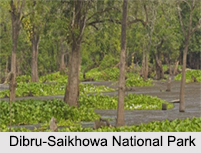 The state of Assam is located in the north eastern part of India. Tea and silk produced in this state have made it popular in India. The natural beauty of Assam, along with temples, museums, rock cut caves, etc attract a number of tourists to this state. Assam also has national parks, which are protected areas maintained to provide shelter to the flora and flora in the state.
The state of Assam is located in the north eastern part of India. Tea and silk produced in this state have made it popular in India. The natural beauty of Assam, along with temples, museums, rock cut caves, etc attract a number of tourists to this state. Assam also has national parks, which are protected areas maintained to provide shelter to the flora and flora in the state.
Kaziranga National Park
Kaziranga National Park is located in the Kaliabor subdivision of Nagaon district and the Bokakhat subdivision of Golaghat district. It was established in 1908 and occupies an area of about 430 square kilometers. This national park has been designated as a UNESCO World Heritage Site and a Bird Area by BirdLife International. Some of the occupants of the park are alluvial inundated grasslands, tropical moist mixed deciduous forests, elephants, gaurs, sambars, Indian muntjacs, Indian tigers and leopards.
Manas National Park
 Manas National Park is located in Himalayan foothills in Assam. It was declared a national park on 13th of April 1999 and occupies an area of about 950 square kilometers. This park has various other designations. This park is also a UNESCO Natural World Heritage site, a Project Tiger reserve, an elephant reserve and a biosphere reserve. This park is occupied by sub-Himalayan light alluvial semi-evergreen forests, sub-Himalayan light alluvial semi-evergreen forests, low alluvial savanna woodland, Indian elephants, Indian rhinoceros, gaurs, Asian water buffaloes, birds, reptiles, etc.
Manas National Park is located in Himalayan foothills in Assam. It was declared a national park on 13th of April 1999 and occupies an area of about 950 square kilometers. This park has various other designations. This park is also a UNESCO Natural World Heritage site, a Project Tiger reserve, an elephant reserve and a biosphere reserve. This park is occupied by sub-Himalayan light alluvial semi-evergreen forests, sub-Himalayan light alluvial semi-evergreen forests, low alluvial savanna woodland, Indian elephants, Indian rhinoceros, gaurs, Asian water buffaloes, birds, reptiles, etc.
Nameri National Park
Nameri National Park in located in the foothills of the eastern Himalayas in the Sonitpur district. It was established in 1978 and occupies an area of about 200 square kilometers. Some of the inmates of this park are semi-evergreen, moist deciduous forests, tiger, leopard, sambar, dhole, pygmy hog and birds. Rivers in this park provide opportunity for angling and rafting. People can also indulge in an adventurous activity called trekking in the park.
Dibru-Saikhowa National Park
Dibru-Saikhowa National Park is located at about 12 km north of Tinsukia town. It was established in 1999 and occupies an area of about 350 square kilometers. The national park is occupied by moist mixed forest, degraded forest, grassland, royal Bengal tiger, clouded leopard and jungle cat, reptiles, birds, etc.
Orang National Park
Orang National Park is housed on the north bank of the Brahmaputra River in the Darrang and Sonitpur districts. It was established in 1999 and occupies an area of about 78.81 square kilometers. This park is occupied by royal Bengal tiger, Asiatic elephant, pygmy hog, hog deer and wild boar, fish, reptiles, birds, etc.



















